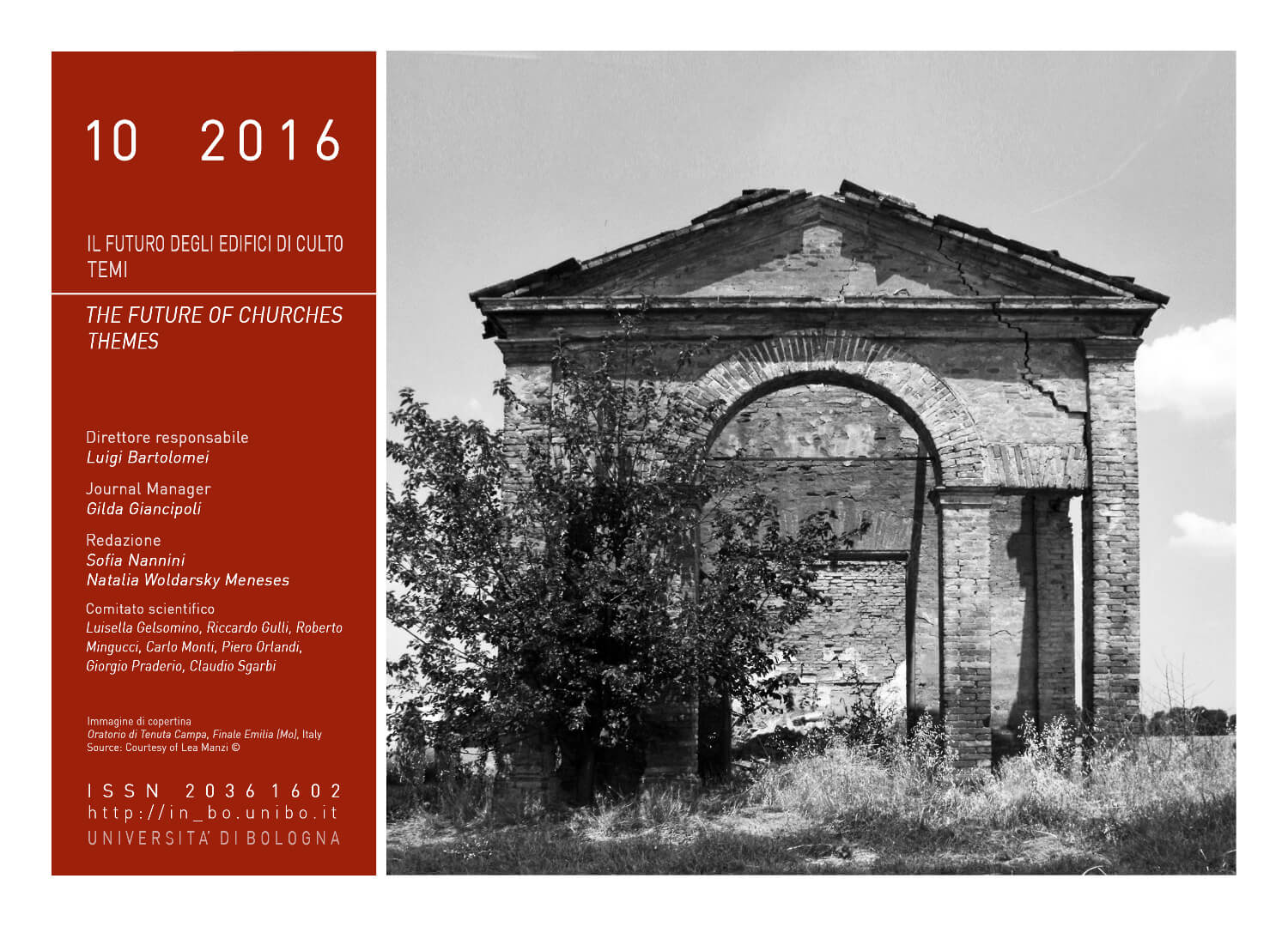From Church to Columbarium: the German approach to the conversion of underused places of worship
DOI:
https://doi.org/10.6092/issn.2036-1602/6478Keywords:
Church, Colombarium, Germany, Transformation, Dominikus Böhm, Hans SchwippertAbstract
A building can be abandoned for several reasons, such as structural, functional, economics, socio historical issues. If it is a church, other factors had to be considered. In fact, the secularization of modern society is a wide phenomenon that involves all faiths from Catholics to Protestants, both in rural district and metropolis. The sacral building loses gradually its functionality and, due to high management costs, the owners (principally dioceses) had to optimize their financial resources. In particular, my study is focused on Germany where there is an ongoing transformation process of underused churches, in order to give them a new function and a new life. It led to convert church into ossuary (or columbarium). For this reason, it is important to stress that the cremation was not introduced in Germany until 1879 and since then columbaria were often built on external walls of many cemeteries. The current assumption is the impossibility to expand existent graveyards and the need to recycle religious buildings in ruins. The building sacredness is preserved, whereas liturgical function fails or is reduced. As a simple empty building, the church keeps its external volume but the interior space is adapted to the new functional requirements. This process, which started from 1990s, is emerging in the last decade. Two churches will be here analyzed. In particular, St. Kamillus in Mönchengladbach was built by Dominikus Böhm (1928-1931) and converted by BDMP | Architekten BDA (2015); St. Bartholomäus in Cologne was designed by Hans Schwippert (1960) and converted by Kissler + Effgen (2014).References
Aa.Vv., Paolo Antonio Martini (a cura di), L’arte del costruire nel costruito: Recupero e rinnovo urbano, Electa, Firenze 1982
Luigi Bartolomei, “Morte e vita nuovi equilibri nel paesaggio italiano”, in IN_BO. Ricerche e progetti per il territorio, la città e l’architettura, Università di Bologna, 2015, 6(8), pp. 143-149
Luigi Bartolomei, Giorgio Praderio, “Evoluzioni contemporanee nell'architettura cimiteriale contemporanea”, in IN_BO. Ricerche e progetti per il territorio, la città e l’architettura, Università di Bologna, 2012, 3(4), pp. 1-4
Françoise Choay, L’allegoria del patrimonio, Officina, Roma 1995.
Winfried Nerdinger, Cornelius Tafel, Guida all’architettura del Novecento. Germania, Electa, Milano 1996, p. 278
Alois Riegl, Stilfragen. Grundlegungen zu einer Geschichte der Ornamentik Stilfragen, Berlin 1893. [trad. it. Alois Riegl, Problemi Di Stile. Fondamenti Di Una Storia Dell'arte Ornamentale, Feltrinelli 1963.]
Giuseppe Strappa (a cura di), Edilizia per il culto. Progettare. Metodi, tecniche, norme, realizzazioni, UTEC, Torino 2005, vol. 5.
Chiara Tilocca, Andrea Zangari, A. (2015) “Grabeskirche – La chiesa die sepolcri: un nuovo modello per cimiteri di quartiere? “, in IN_BO. Ricerche e progetti per il territorio, la città e l’architettura, Università di Bologna, 2015, 6(8), pp. 229-241
Wolfgang Voigt, Ingeborg Flagge (a cura di), Dominikus Böhm 1880-1955, Ernst Wasmuth Verlag, Tübingen / Berlino 2005
http://www.grabeskirchekoeln.de/
http://www.dbk.de/zahlen-fakten/kirchliche-statistik/
http://www.koelnarchitektur.de/pages/de/news-archive/8787.htm
www.st-kamillus-kolumbarium.de
www.bdmp-architekten.de
Downloads
Published
How to Cite
Issue
Section
License
Copyright (c) 2017 Giovanni Carbonara
Copyrights and publishing rights of all the texts on this journal belong to the respective authors without restrictions.
This journal is licensed under a Creative Commons Attribution-NonCommercial 4.0 International License (full legal code).
See also our Open Access Policy.
Metadata
All the metadata of the published material is released in the public domain and may be used by anyone free of charge. This includes references.
Metadata — including references — may be re-used in any medium without prior permission for both not-for-profit and for-profit purposes. We kindly ask users to provide a link to the original metadata record.







